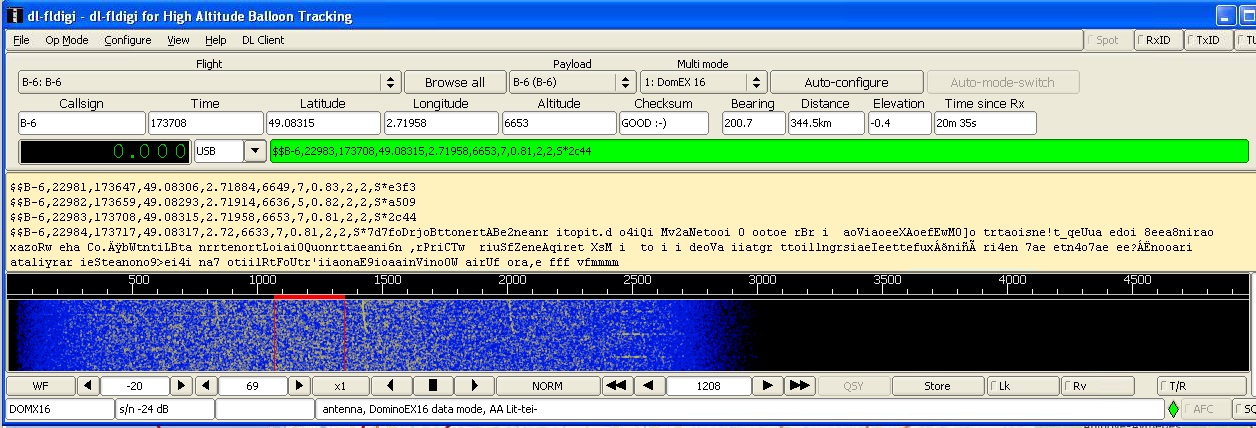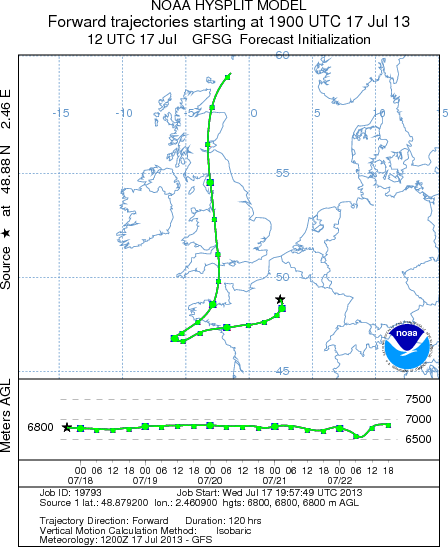
Altitude profile.
As a (completely unexpected) result B-6 has flown almost 71 hours and has become the second longest duration flight of amateur radio balloon worldwide surpassing records set by transatlantic balloons crossings. At the moment this is the UK longest duration amateur balloon flight.
Some flight results:
Tracker hardware is identical to B-2 flight but uses AA battery instead
Payload weight: 20.2 grams
Flight duration: 70.9 hours (from 14/Jul/2013 18:42 UTC till 17/Jul/2013 17:37 UTC - last known position)
Launch site: Silverstone, UK
Last known position: 6633 metres above Paris, France
Float duration: 68.7 hours (last known position was in float state)
Power source: 1xAA battery
Free lift: 1.3 grams.
Downlink mode: DominoEX 16 on 434.500MHz
Transmitter power level: 10mW
Raw telemetry data
I would like to thank everybody who put their efforts, time and equipment into either receiving telemetry during the flight or logging into the #highaltitude IRC channel to discuss B-6 flight progress.
There are too many to mention - here is the list of callsigns who submitted telemetry reports: F5APQ, F5CT, F5VMH, M0MDB, PA3WEG, F5MVO, G7OGX, G8KNN, ASTRA, G0TDJ, PB0AHX, G4MYS, G6UIM, F4FWT, G8FEZ, G6GZH, G8KNN-1, G8DHE-1, G0NZO, G7UXW, M0JCU, M6RPI, F1JSU, M0LEP, M6EDF, RevSpace, h4yn0nnym0u5e, ON5LT, M0UPU, on2bj, PB0NER, M0DNY, M6CSV, G6SUQ, G4SGX, M1ARI, 2E0KPI, G0HWW, M0VBR, F5DMY, F4GYW, PE2G, ON5HY, G8DHE/m-1, G0CXW, jijdaar, G8DHE-M.
Special thanks to HAB supplies for supplying MAX-7 GPS modules.
Leo Bodnar
leo@leobodnar.com
Launch was uneventful apart from the need to replace damaged MAX-7 GPS module. The launch has been delayed by 1 hour 40 minutes.
After balloon has been released it climbed to 5400 metres where it spent all night drifting over the channel towards France.
Many receiving stations from the UK and Netherlands kept track of its progress overnight over large distances due to incredibly low signal reception capability of Domino EX 16 mode used for the data downlink.
Thanks to transmitter frequency aligned to GPS reference most reception equipment has been left unattended and did not require manual correction for frequency drift. Typical frequency drift was within 10-20Hz while Domino EX 16 allows for almost 200Hz drift before signal becomes unreadable. This unattended capability has been extremely useful considering that total flight time for B-6 was three full days and nights.
a Sunrise caused Helium pressure inside the balloon to increase and aluminised nylon envelope to stretch much further than during the night and moving from initial elastic deformation deep into plastic deformation region.
Resulting decrease in system density resulted in the balloon climbing 1400 metres and floating at a higher altitude of 6800 metres over France towards Paris.
With second night approaching B-6 descended by 500 metres and settled at 6300 metres altitude. Notice that this is much higher than the first night due to the fact that envelope has been irreversibly stretched during the first day.
B-6 spent second night over Paris having drifted only 20 miles in 12 hours.
Second day turned out to be much more dramatic. Floating at the altitude of 6800 metres North towards Calais something has caused B-6 to dive 2000 metres. Most probable cause of this was highly turbulent and unstable weather in the region. B-6 spent the next 6 hours trying to climb to daily floating altitude only to being hammered again lower and lower.
Towards the end of the day it has settled into aalmostmost 5000 metres descent - at one point leaving the ground track reminding landing pattern over Matringhem.
All hope was lost as it was evident that this stable and consistent descent will soon result in landing - luckily just few miles away from one of the most active French tracking stations - F5APQ. There were expectations that as a result B-6 can be found and retrieved.
However at an altitude of 1900 metres over Saint-Omer descent stopped, balloon made quick 180 degrees turn and started ascending again while travelling South - in the opposite direction it has arrived from.
By sunset B-6 slowly climbed to just over 3000 metres and kept floating for awhile South tracing its path backwards and arriving at this altitude over Abbeville. It then started to ascend and by very early morning has reached 5500 metres when unstable weather has caused it to lose another 1000 metres in altitude. By this time the ballon spent almost 24 hours below its calculated floating altitude unable to climb or land. Online discussion produced a lot of speculation of what could have been the cause of such perturbation and what happened as a result. It was expected that balloon has been well battered by now and probably collected moisture/icing and lost Helium.
As if denying all these worries B-6 started climbing and by midday has been healthily floating at its usual 6800 metres day cruise level.
During this third day air movement has caused it to lose another 2000 metres which it quickly recovered from.
By late afternoon B-6 has been floating over Paris again, having visited Calais region and returned unscathed.
At this point inevitable happened, a single AA battery finally run out of energy and its telemetry link stopped. B-6 stopped transmitting after clocking 71 hours while still floating fully inflated over its seemingly favourite city.
NOAA wind movement prediction shows that if B-6 stays afloat it will turn West, turn around over the Bay of Biscay and having finally left France return to the UK, traversing the whole country from South to North and continuing its path further over Norwegian Sea. But what happens in reality - nobody knows.

Flight path.

Altitude profile.

Flight path over France.

Flight path detail during descent in turbulent weather.

Descent turn around and climb. Receivers icons can be seen along the top edge of the map.

B-6 flight telemetry has produces large amount of data on the tracking website.

Last decoded position as received by PA3WEG station in the Netherlands - 345 km away.

Next 5 days prediction for B-6 starting at its last known position over Paris.
 |
Leo Bodnar
leo@leobodnar.com